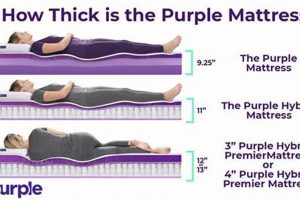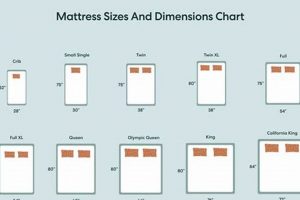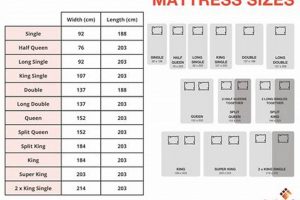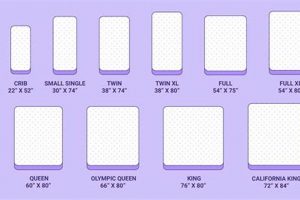A non-standard mattress dimension, also known as an antique or three-quarter bed, measures approximately 48 inches wide and 75 inches long. This size sits between a twin and a full mattress, offering a sleeping surface suitable for a single sleeper who requires more width than a standard twin but less than a full-size bed provides. For instance, it can be found in older homes or used in settings where space is a constraint, such as guest rooms or smaller apartments.
The utility of this particular mattress dimension lies in its space-saving nature, which is especially pertinent in environments with limited square footage. Historically, this size was more prevalent, reflecting the dimensions of bedrooms in older housing stock. Today, its value resides in its ability to fit antique bed frames or to offer a slightly more spacious sleep surface than a twin without consuming the room a full-size bed would require. This makes it an appealing option for smaller rooms or for individuals who prefer a more compact sleeping arrangement.
Given the unique proportions of this mattress size, selecting appropriate bedding and frames requires specific attention. The subsequent sections will detail considerations for sourcing bedding, compatible bed frames, and the overall suitability of this dimension for various sleep needs and living spaces.
Considerations for Selecting a 3/4 Size Mattress
The following recommendations are intended to provide guidance when choosing this mattress, ensuring an informed decision based on individual needs and spatial constraints.
Tip 1: Measure Available Space Precisely: Before any purchase, accurately measure the intended location. A 48×75 inch mattress occupies a specific footprint; ensure sufficient clearance for movement and other furniture.
Tip 2: Prioritize Bed Frame Compatibility: Given the non-standard dimensions, verify that the chosen bed frame is specifically designed for or adaptable to accommodate a 3/4 dimension. Antique frames may require restoration or modification.
Tip 3: Assess Sleeper Suitability: This size is best suited for single sleepers. Consider the individual’s height and sleeping habits. Taller individuals may find the length restrictive.
Tip 4: Evaluate Mattress Firmness: Firmness is a subjective preference. However, consider body weight and preferred sleeping position. Side sleepers may benefit from a softer surface, while back sleepers might prefer a firmer support.
Tip 5: Scrutinize Material Composition: Materials affect both comfort and durability. Memory foam, innerspring, and latex options each offer distinct characteristics. Research the pros and cons of each material regarding support, temperature regulation, and longevity.
Tip 6: Investigate Bedding Availability: Due to the unique dimensions, standard bedding may not fit properly. Explore specialized retailers or consider custom-made options for sheets, comforters, and mattress protectors.
Tip 7: Consider Customization Options: For individuals with specific needs or preferences, custom mattress manufacturers can create a product tailored to exact specifications, including firmness, material composition, and size.
Selecting a suitable mattress of this dimension involves careful evaluation of spatial limitations, compatibility with existing or planned bed frames, and an assessment of individual sleep preferences. Thorough research and precise measurements are crucial.
The subsequent discussion will address where to find these mattresses, evaluate their long-term cost, and outline specific care and maintenance practices to maximize longevity.
1. Dimensions
The defining characteristic of a 3/4 size mattress resides in its specific dimensions, approximately 48 inches in width and 75 inches in length. These measurements dictate its suitability for certain applications and differentiate it from standard mattress sizes. The impact of these dimensions is direct: they determine the mattress’s capacity to fit within particular bed frames and its ability to comfortably accommodate a single sleeper. A failure to adhere to these dimensional standards renders the mattress unsuitable for its intended purpose, leading to instability, discomfort, or incompatibility with existing bedroom furniture. For example, attempting to place a 3/4 size mattress on a full-size bed frame results in inadequate support and potential damage to the mattress.
Understanding these dimensions is practically significant during purchase and setup. Prior measurement of the available space is crucial to ensure that the mattress, along with its frame, fits appropriately. The 48-inch width provides more lateral space than a standard twin mattress, making it suitable for individuals who prefer additional room to move during sleep. However, the 75-inch length may present limitations for taller individuals. Awareness of these dimensional constraints enables informed decision-making, minimizing the risk of selecting a mattress that proves either too large or too small for the designated area or user.
In summary, the dimensions of a 3/4 size mattress are paramount to its functionality and usability. They dictate frame compatibility, spatial efficiency, and sleeper comfort. While offering a niche solution for specific needs, the non-standard nature of these dimensions necessitates careful planning and precise measurement to avoid practical challenges. Ignoring this critical aspect undermines the benefits of this unique mattress size, potentially leading to dissatisfaction and unnecessary expense.
2. Bedding Availability
The availability of bedding tailored to the specific dimensions of a 3/4 size mattress (approximately 48 inches wide and 75 inches long) directly impacts its practicality and overall value proposition. Unlike standard sizes such as twin, full, queen, or king, bedding designed for the 3/4 size is not commonly stocked by major retailers. This relative scarcity results in a cause-and-effect relationship: the limited demand translates into lower production volumes, subsequently affecting price and accessibility for consumers. For instance, a consumer requiring fitted sheets, mattress protectors, or comforters for this dimension may encounter significantly fewer options and higher costs compared to shopping for standard-sized bedding.
The importance of addressing bedding availability stems from its functional necessity. Without appropriately sized sheets, the comfort and hygiene of the mattress are compromised. Oversized bedding can bunch and wrinkle, leading to discomfort and reduced sleep quality. Conversely, standard twin-size bedding, while closer in size, will not adequately cover the mattress, potentially exposing it to dirt and damage. Historically, sewing custom bedding was a common solution, but this adds time and expense. Modern alternatives include searching specialty online retailers or opting for adjustable bedding solutions designed to fit multiple mattress sizes within a narrow range.
In summary, the limited availability of bedding for 3/4 size mattresses represents a significant practical challenge. This factor influences the overall cost of ownership, the convenience of maintaining the mattress, and the overall comfort experienced by the sleeper. While niche markets and custom solutions exist, prospective buyers must consider this aspect when evaluating the suitability of this mattress size, as it directly impacts the long-term usability and satisfaction derived from the product.
3. Frame Compatibility
Frame compatibility presents a critical consideration when selecting a 3/4 size mattress due to its non-standard dimensions. A mismatch between the mattress size and bed frame can compromise both the structural integrity of the bed and the comfort of the sleeper. The issue stems from the mattress’s unique 48-inch by 75-inch proportions, which differ from commonly available sizes. For example, placing this mattress on a full-size (54-inch wide) frame results in excessive gaps and inadequate support, while attempting to fit it within a twin-size (39-inch wide) frame is physically impossible. This incompatibility directly affects the mattress’s lifespan and the sleeper’s experience, leading to premature wear, uneven weight distribution, and potential injury.
Proper frame selection is paramount for ensuring adequate support, promoting air circulation, and maintaining the mattress’s shape. A correctly sized frame provides a stable foundation, preventing sagging and prolonging the mattress’s usability. Furthermore, the frame contributes to airflow, reducing the risk of moisture buildup and the growth of mold or mildew. Antique bed frames, often designed for this mattress size, may require restoration or modification to guarantee optimal support and compatibility with modern mattresses. Conversely, purchasing a new frame specifically designed for this dimension minimizes the risk of incompatibility and ensures proper alignment and weight distribution. An improperly supported mattress is more prone to degradation, necessitating earlier replacement and incurring additional costs.
In conclusion, frame compatibility represents a non-negotiable aspect of selecting a 3/4 size mattress. The non-standard dimensions necessitate careful consideration of frame size and structural integrity to ensure proper support, promote longevity, and optimize sleeper comfort. Neglecting this critical element undermines the potential benefits of the mattress, leading to practical challenges and reduced overall satisfaction. Therefore, thorough assessment and precise measurement are crucial steps in the purchase and setup process.
4. Sleeper Suitability
The appropriateness of a 3/4 size mattress for a given individual, termed here as “sleeper suitability,” hinges on a confluence of factors related to physical attributes, sleeping habits, and personal preferences. These elements must be carefully evaluated to ensure that the mattress meets the specific needs of the user, optimizing comfort and promoting restful sleep.
- Height and Body Size
A primary determinant of sleeper suitability is the individual’s height. With a length of approximately 75 inches (6 feet 3 inches), a 3/4 size mattress may prove insufficient for taller individuals, leading to discomfort and restricted movement. Body size, particularly weight distribution, also influences suitability; individuals with broader shoulders or hips may find the 48-inch width constricting. For example, a person exceeding 6 feet in height is unlikely to find adequate support or comfort on this mattress size, regardless of other factors.
- Sleeping Position
Preferred sleeping position affects the suitability of this mattress. Side sleepers require adequate space to turn and reposition, while back sleepers need sufficient support to maintain spinal alignment. The limited width of the 3/4 size mattress may restrict movement for side sleepers, potentially causing discomfort. Stomach sleepers, who often spread out more, are also likely to find the dimensions restrictive. The mattress is generally most suitable for back sleepers of average build who do not require extensive space for movement.
- Personal Space Preferences
Individual preferences regarding personal space during sleep are a significant factor. Some individuals prefer a more spacious sleeping surface, valuing the freedom to move and stretch without constraint. For these individuals, the relatively compact dimensions of the 3/4 size mattress may prove unsatisfactory, regardless of their physical size or sleeping position. Conversely, individuals who prefer a cozier sleeping environment or those accustomed to smaller sleeping surfaces may find the 3/4 size mattress perfectly adequate.
- Physical Conditions and Mobility
Physical conditions, such as chronic pain, mobility limitations, or age-related stiffness, also influence sleeper suitability. Individuals with conditions requiring frequent repositioning or those who experience discomfort from confined spaces may find the 3/4 size mattress restrictive. Those with limited mobility may struggle to get in and out of a bed of this size, particularly if the bed frame is low to the ground. In these cases, a larger mattress or an adjustable bed may be more appropriate to accommodate specific needs.
In summary, determining sleeper suitability for a 3/4 size mattress necessitates a holistic assessment of physical attributes, sleeping habits, personal preferences, and any underlying physical conditions. While the mattress may offer a space-saving solution for some, its dimensions may not be conducive to optimal comfort and restful sleep for all individuals. A careful evaluation of these factors is crucial to ensuring satisfaction and avoiding potential discomfort or sleep disturbances.
5. Cost Considerations
The economic implications surrounding a 3/4 size mattress extend beyond the initial purchase price. Evaluating the total cost of ownership necessitates considering multiple factors, including mattress price, bedding costs, frame compatibility expenses, and potential replacement frequency. These elements collectively determine the long-term financial impact of choosing this non-standard mattress size.
- Initial Mattress Price
While a 3/4 size mattress may appear less expensive than larger alternatives like queen or king, the price difference may be less significant than anticipated. Reduced production volume due to lower demand can sometimes result in higher unit costs. Price comparison with readily available sizes is essential to accurately assess initial expenditure. For example, a specialty retailer may offer this size at a premium compared to a standard full-size mattress from a mass-market vendor.
- Bedding Acquisition Expenses
Obtaining appropriately sized bedding presents a recurring cost consideration. Due to limited availability, standard bedding sizes are unsuitable, necessitating the purchase of specialty-sized sheets, comforters, and mattress protectors. These items are often priced higher than their standard counterparts, reflecting the lower production volumes and specialized distribution channels. Over time, bedding costs can significantly contribute to the overall financial burden.
- Frame Compatibility Investment
Securing a compatible bed frame can represent a substantial expense. Antique frames, often designed for this mattress size, may require restoration or modification to ensure structural integrity and proper support. Alternatively, custom-built frames provide a tailored solution but incur higher upfront costs. Neglecting frame compatibility can lead to premature mattress wear, necessitating earlier replacement and escalating long-term costs.
- Longevity and Replacement Frequency
The lifespan of a 3/4 size mattress, influenced by factors such as material quality, usage patterns, and frame support, directly affects replacement frequency. While high-quality materials and proper maintenance can extend longevity, the non-standard dimensions may limit the availability of replacement options or increase their cost. Predicting replacement needs and factoring these potential expenses into the initial cost assessment is crucial for accurate financial planning.
In conclusion, cost considerations surrounding a 3/4 size mattress encompass a range of interconnected expenses. While the initial purchase price may seem attractive, bedding costs, frame compatibility investments, and replacement frequency can significantly impact the long-term financial burden. A comprehensive evaluation of these factors is essential for making an informed and economically sound decision. Comparison with readily available mattress sizes and exploration of alternative solutions should be undertaken before committing to this non-standard option.
6. Material Options
The selection of materials in a 3/4 size mattress directly influences its performance characteristics, durability, and overall suitability for individual needs. Given the non-standard dimensions of this mattress size, material choices become even more critical, impacting factors such as support, temperature regulation, and longevity. For instance, an innerspring mattress, while providing traditional support, may exhibit reduced edge support in a 3/4 size due to the smaller surface area. Conversely, memory foam, known for its conforming properties, can offer enhanced pressure relief, but may also retain heat, potentially leading to discomfort for some sleepers. The available materials directly impact comfort.
The material composition also affects the mattress’s long-term viability and maintenance requirements. Latex, known for its durability and hypoallergenic properties, can be a suitable option, but it often commands a higher price point. Polyurethane foam, a more economical alternative, may degrade more rapidly, necessitating earlier replacement. Furthermore, the cover material plays a crucial role in breathability and moisture management. A cotton or bamboo cover enhances airflow, reducing the risk of moisture buildup and microbial growth. Understanding these material properties enables informed decision-making, ensuring the selection of a 3/4 size mattress that aligns with specific comfort preferences, budgetary constraints, and maintenance considerations. For example, people with allergy would choose material which has hypoallergenic properties. The material impact life style.
In summary, the material options for a 3/4 size mattress are intrinsically linked to its performance, longevity, and suitability. A comprehensive understanding of the properties of different materials, including innerspring, memory foam, latex, and polyurethane foam, is essential for making an informed purchasing decision. Careful consideration of these factors ensures that the selected mattress provides optimal comfort, support, and durability, maximizing the value and minimizing the potential for premature replacement. The material make value of the product. Thus material is important consideration when selecting a mattress.
7. Space Efficiency
Space efficiency, defined as the maximization of usable area within a confined environment, directly correlates with the utility of a 3/4 size mattress. The mattress’s dimensions, smaller than a full-size bed but larger than a twin, position it as a potential solution for optimizing limited square footage in bedrooms, apartments, or other living spaces. The value of space efficiency is increasing as housing costs and urbanization trends require more strategic use of available space.
- Room Layout Optimization
The 3/4 size mattress allows for greater flexibility in room layout design. Its reduced footprint enables the incorporation of additional furniture or increased open space within a bedroom. For example, a small guest room might accommodate a desk or seating area that would be precluded by a larger bed. The strategic placement of furniture becomes more attainable, leading to improved functionality and aesthetics within the given space.
- Apartment Living and Small Dwellings
In apartment settings and smaller homes, every square foot holds significant value. The dimensions of a 3/4 size mattress are particularly well-suited for these environments, providing a sleeping surface that doesn’t dominate the room. This is especially pertinent in urban areas where smaller living spaces are often the norm. The mattress facilitates a more balanced allocation of space for living, working, and sleeping within the confines of a compact dwelling.
- Multi-Purpose Room Design
The 3/4 size mattress supports the creation of multi-purpose rooms, where a single space serves multiple functions. For instance, a room might be used as both a home office and a guest bedroom. The smaller mattress footprint allows for easier conversion between these uses, as it occupies less space when not in use as a sleeping surface. This adaptability is crucial for maximizing the utility of limited space within a home.
- Dormitories and Shared Living Spaces
In shared living environments, such as dormitories or co-living arrangements, space efficiency is paramount. The 3/4 size mattress provides a compromise between individual comfort and spatial conservation. It offers a more generous sleeping surface than a twin mattress while still allowing for efficient use of the shared living area. This promotes a more balanced and functional living environment for multiple occupants.
These facets highlight the reciprocal relationship between space efficiency and the 3/4 size mattress. By optimizing room layout, adapting to smaller dwellings, enabling multi-purpose room design, and fitting shared living spaces, the mattress proves to be a space-conscious solution for a range of environments. The practical advantages stemming from its compact dimensions make it a viable alternative to larger beds when space is a primary consideration.
Frequently Asked Questions
This section addresses common inquiries and concerns related to the 3/4 size mattress, offering clarity on its dimensions, suitability, and practical applications.
Question 1: What are the precise dimensions of a 3/4 size mattress?
The standard dimensions of a 3/4 size mattress are approximately 48 inches in width and 75 inches in length. These measurements are crucial for determining frame compatibility and spatial suitability.
Question 2: Is a 3/4 size mattress suitable for two individuals?
A 3/4 size mattress is generally not recommended for two individuals. Its limited width provides insufficient space for comfortable and restful sleep for multiple occupants.
Question 3: Where can bedding for a 3/4 size mattress be purchased?
Bedding specifically designed for a 3/4 size mattress may require sourcing from specialty retailers or online vendors. Custom-made bedding represents an alternative solution, though often at a higher cost.
Question 4: How does the cost of a 3/4 size mattress compare to standard mattress sizes?
The initial purchase price may be less than larger sizes; however, bedding and frame costs can offset this difference. Total cost of ownership should be carefully evaluated.
Question 5: What type of bed frame is appropriate for a 3/4 size mattress?
Bed frames specifically designed for a 3/4 size mattress, often antique frames, are recommended. Standard frames may require modification to ensure proper support and stability.
Question 6: Is a 3/4 size mattress suitable for taller individuals?
Taller individuals may find the 75-inch length restrictive. Assessing individual height is critical in determining the suitability of this mattress size.
These FAQs provide a concise overview of key considerations when evaluating a 3/4 size mattress. Understanding these points is essential for making an informed decision.
The subsequent section will present a summary of the benefits and limitations associated with this particular mattress size.
In Summary
This exploration has detailed the nuances of the 3/4 size mattress, elucidating its dimensions, sleeper suitability, material options, and the economic factors influencing its adoption. It has highlighted the challenges associated with bedding availability and frame compatibility, emphasizing the importance of meticulous planning and precise measurement before purchase. The discussion has underscored its potential as a space-saving solution, particularly within constrained living environments, while acknowledging its limitations for taller individuals and couples. The 3/4 size mattress, therefore, represents a targeted solution with specific benefits and constraints.
The selection of a 3/4 size mattress requires a thorough assessment of individual needs and spatial considerations. Its value lies in its targeted application, offering a compromise between a twin and full size, suited for individual sleepers in space-limited settings. The ultimate decision necessitates a balanced evaluation of its advantages and disadvantages, ensuring that it aligns with the intended use and long-term practicality. A considered choice, informed by the factors presented, will optimize both comfort and space utilization.


![Best Queen Size Foldable Mattress [Guide] Organic & Natural Mattress Buyer’s Guide: Non-Toxic Sleep Solutions Best Queen Size Foldable Mattress [Guide] | Organic & Natural Mattress Buyer’s Guide: Non-Toxic Sleep Solutions](https://mattressworldpa.com/wp-content/uploads/2025/07/th-2272-300x200.jpg)


![Best Queen Size Floor Mattress [Guide] Organic & Natural Mattress Buyer’s Guide: Non-Toxic Sleep Solutions Best Queen Size Floor Mattress [Guide] | Organic & Natural Mattress Buyer’s Guide: Non-Toxic Sleep Solutions](https://mattressworldpa.com/wp-content/uploads/2025/07/th-2269-300x200.jpg)

